Severely malnourished under-5 children consumed by hunger in the pandemic
Almost 43% of under the age of six kids in the country, suffering from severe acute malnutrition, are in Uttar Pradesh. COVID pandemic, loss of livelihoods, overburdened healthcare system and disrupted anganwadi services have made matters worse in the state. A Gaon Connection report.
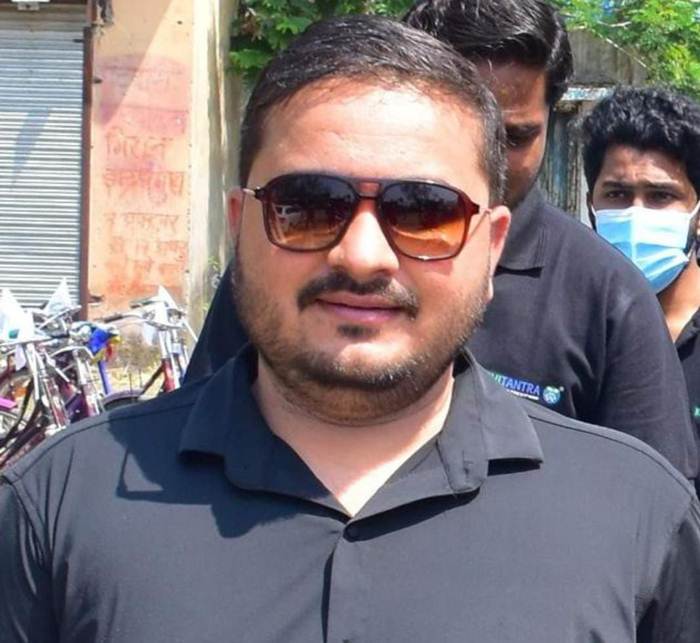
Sitapur, Uttar Pradesh
Kanti Devi gave birth to her second son Anmol three months ago. Her older son Adit is one-and-a-half years old. Her eyes sick with worry, Kanti Devi tended to her baby boy.
At three months, Anmol should have weighed over six kilograms (kgs). But lying on a bed at the nutritional rehabilitation centre in Sitapur, Uttar Pradesh, his recorded weight was half of that, at three kilograms.
Not too far away, on another cot, played Adit, Kanti Devi’s older son who weighed 6 kg at 18 months. “Both my sons have fever and diarrhoea,” Kanti Devi told Gaon Connection. “I took them to the community health centre at Tambour, and I was asked by the doctor there to bring them to the district hospital,” she said.
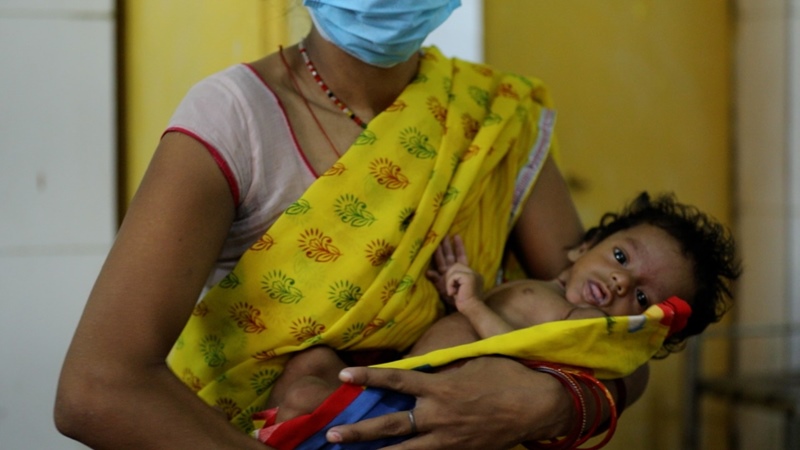
Kanti Devi is from Basantapur in Behta block of Sitapur district, about 112 kilometres from the state capital Lucknow. The frail 27-year-old, herself a patient of tuberculosis (TB), gave birth to Anmol in March. Both her children are currently undergoing treatment for malnutrition at the district hospital.
“Anmol and Adit both fall into the severe acute malnutrition category or the red category of malnutrition,” Mohammed Afaq, the doctor treating them at the nutritional rehabilitation centre, at the district hospital in Sitapur, told Gaon Connection. He added that 18-month-old Adit showed signs of TB and had eczema. Kanti Devi herself is undernourished, the doctor said.
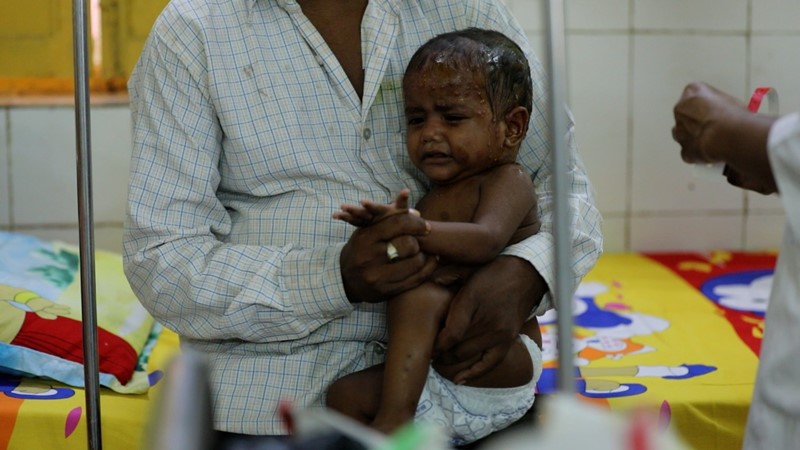
“We are seeing difficult times,” Om Prakash, Kanti Devi’s husband, told Gaon Connection. There was sadness in his voice as he revealed they had lost their three-year-old daughter Anshika (who also had TB) to malnutrition in 2018. That memory still haunts them. And now both their sons — Anmol and Ankit — are in the ‘red category’.
Also Read: What is the cost of childhood wasting and severe acute malnutrition in India?
In a recent RTI query, the Women and Child Development Ministry stated that till last November it had identified 927,606 severe acute malnourished (SAM) kids between the age groups of six months and six years across the country. Of these, the highest — 398,359 SAM kids — were in Uttar Pradesh followed by Bihar (279,427).
Simply put, almost 43 per cent of all under-6 SAM category kids in India are in Uttar Pradesh and 30 per cent are in Bihar (see map: Top 10 states with highest under-6 SAM children). SAM significantly increases the risk of death in children under five years of age and such children need institutional care.
Map: Top 10 states with highest under-6 SAM children
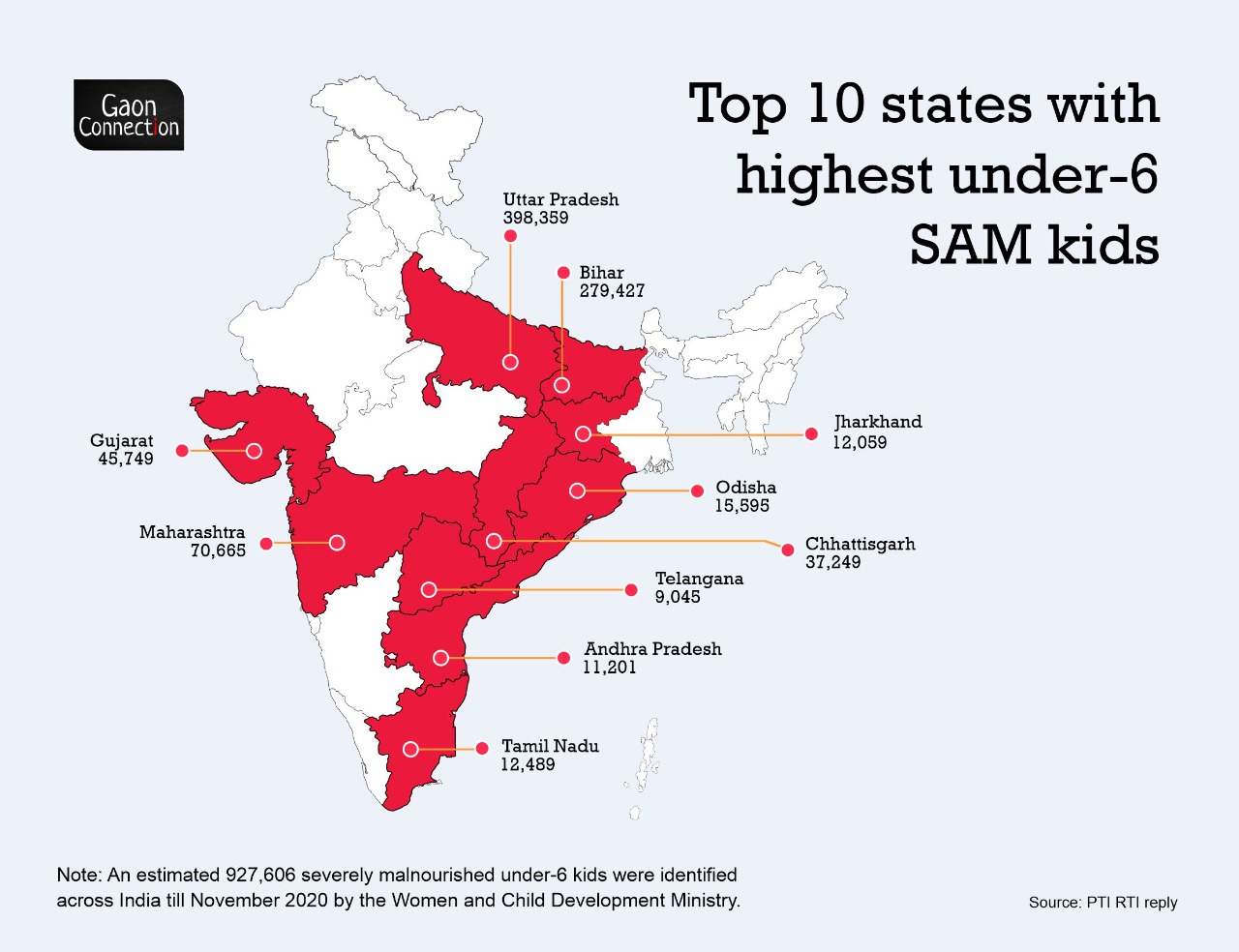
Growing burden of malnutrition
Based on the health status of malnourished children, the World Health Organization (WHO) categorises kids as severe acute malnutrition (SAM) and moderate acute malnutrition (MAM) kids. Unlike SAM children, children with MAM can be managed in the outpatients setting where there is a provision for supplementary feeding.
National level data on malnourished children paints a grim picture. As per the Comprehensive Nutrition National Survey (CNNS) of 2016-18, 35 per cent of Indian children aged 0-4 years were stunted (low height for age) and 33 per cent under-4 kids were underweight.
This national survey found 38.8 per cent under-4 kids were stunted in Uttar Pradesh (see graph 1: State-wise percentage of stunted children (0-4 years) in India). Almost 37 per cent under-4 children in the state were underweight (see graph 2: State-wise percentage of underweight children (0-4 years) in India).
Graph 1: State-wise percentage of stunted children (0-4 years) in India
Graph 2: State-wise percentage of underweight children (0-4 years) in India
Raj Kapoor, ICDS (Integrated Child Development Services) programme officer of Sitapur district in Uttar Pradesh, told Gaon Connection that in his district there are 543,241 children in the age group 0-5 years. “Of these, 44,610 children fall in the yellow category [MAM] and 8,229 children fall in the red category [SAM],” Kapoor, told Gaon Connection (see map: Under-5 malnourished kids in Uttar Pradesh).
About 383 kilometres from Sitapur, in Mirzapur district of the state, 281,065 children are in the under-5 age category. “In our district, 30,225 under-five children are in the MAM category and 5,977 children are in the SAM category,” Pramod Singh, district programme officer from the child nutrition department, told Gaon Connection.
Similarly, in Unnao district, there are 241,000 children in the age group of 0-5 years. Of these, at least 28,000 are in the yellow category and 4,000 in the red category of malnutrition, Durgesh Singh, programme officer Unnao district, told Gaon Connection.
Map: Under-5 malnourished kids in Uttar Pradesh

In Badaun district, there are a total of 288,706 registered kids in the age group of 0-5 years. Of these, 14,846 are in the MAM category and 4,592 in SAM category.
In Shahjahanpur district, 299,797 children are in the 0-5 years age group. Of these, 9,161 are in MAM and 2,474 in SAM categories.
In Barabanki district, there are 325,965 children in the 0-5 years age group. Of these, 5,436 are in the MAM category and 1,310 in the SAM category.
In Pilibhit district there are 176,784 children who fall in the 0-5 years category. Of these 508 are in SAM and 1,129 in MAM category.
Pandemic, rising hunger and malnutrition
Four-month-old Choti in Belhara village in Ailiya block of Sitapur is refusing nourishment of any kind and weighs just three kgs. “We took her to the district hospital and she was admitted at the nutritional rehabilitation centre, where she was declared ati-kuposhit [severe acute malnutrition],” Meena Devi, Choti’s mother, told Gaon Connection.
Meena Devi and her husband Ramesh Kumar have five children, all below 10-year-of-age. They own no land, and her husband earns a livelihood breaking stones and turning them into grinding stones and going from village to village selling them. But the pandemic and the lockdown have put paid to that and he has no steady income now.
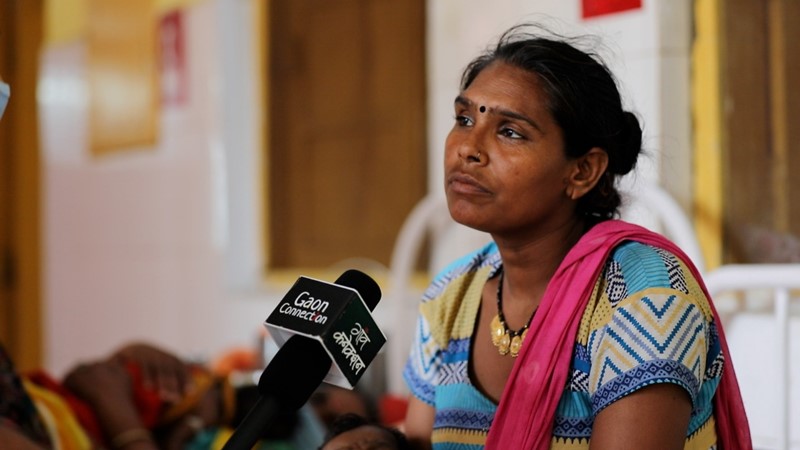
Also Read: Rising hunger stares rural India in the face as the second wave of COVID invades villages
Similar is the condition of Om Prakash, father of Anmol and Adit, two SAM kids from Basantapur village in Sitapur. Om Prakash had five bighas (1 bigha = 0.25 hectare) of ancestral land that was washed away into the Sharada river during the floods, he said. Now a daily wage labourer at a private plywood factory, he earns about Rs 200 a day.
“With the lockdown, even two hundred rupees a day is not assured. And the doctor has advised my wife and children to eat fruits, vegetables and milk,” Om Prakash told Gaon Connection. “We barely get one full meal a day, where am I going to go for fruits, milk and vegetables,” he asked. There were days when they just had namak roti (flattened bread and salt), he complained.
A number of research studies and reports point towards how the pandemic has worsened child health and malnutrition in India. Parents have lost their livelihoods, schools are shut (hence no mid-day meals) and anganwadi services (meals to 0-6 years kids, and pregnant and lactating mothers) are disrupted.

Also Read: For anganwadis, Corona shutdown could mean safety from disease, not from hunger
India Child Well-being Report 2020, released last November, pointed out how the COVID19 pandemic and the subsequent lockdown has put almost 115 million children in the country at the risk of malnutrition. The Global Nutrition Report 2020 has also taken cognisance of the grave economic crisis due to COVID19 in developing countries like India.
Last November, UNICEF released its report, Averting a Lost COVID Generation, which warned that globally an estimated two million additional child deaths and 200,000 additional stillbirths could occur over a 12-month period with severe interruptions to services and rising malnutrition. An additional six to seven million children under the age of 5 will suffer from wasting or acute malnutrition in 2020, a 14 per cent rise that will translate into more than 10,000 additional child deaths per month – mostly in sub-Saharan Africa and South Asia, the international agency highlighted.

Where’s the promised ration?
Government of India’s Integrated Child Development Services (ICDS) scheme is the world’s largest programme for early childhood care and development, with over 158 million children (2011 Census) in the 0-6 years age group, and pregnant and lactating mothers in the country.
ICDS offers six services: supplementary nutrition, preschool non-formal education, nutrition and health education, immunisation, health check-up and referral services, through 1.36 million functional anganwadi centres spread across all the districts in the country (as of June 2018).
Uttar Pradesh has a total of 189,789 anganwadi centres. As per the Bal Vikas Seva Evam Pushtahar Vibhag of the state government, about 8.3 million children between the age group of six months to three years receive take-home ration including daliya, etc.

Another over four million children in the 3-6 years age group receive energy dense sweet daliya, namkeen daliya and special laddus. Similarly, 3.55 million pregnant and lactating women are covered in the state under take-home ration of ICDS.
But with anganwadis shut since the beginning of the pandemic, supplementary nutrition of young children, and pregnant and lactating women has suffered.
Also Read: Centre announces Rs 100 per child under mid-day meal, gets flak from health and nutrition experts
Meena Devi of Belhara village in Sitapur, whose four-month-old daughter is in SAM category, told Gaon Connection that food was scarce and even the dry ration they get from the anganwadi was inadequate to meet their nutritional needs. “If we get wheat, there is no rice, if there is rice, there is no oil, and if we ask the anganwadi people, they do not like it and it ends up in arguments,” she said.
According to Raj Kapoor, programme officer of ICDS, there are 4,232 anganwadi centres in the district. And 182,373 children between the ages of three and six years are enrolled in it.
“The dal that was to be distributed in March has only just arrived in June. We are yet to receive the entire ration for April, May and June,” Kapoor told Gaon Connection.
Anganwadi workers claim they cannot be blamed for non-distribution of ration to beneficiaries. “We have four severely malnourished children in our village,” Rajkumari Mishra, anganwadi worker, at Sumli village, Behta block, told Gaon Connection. “We have not received dry rations since March this year. How do we ensure grains for these children,” she asked.

Apart from distributing ration to beneficiaries, anganwadi workers are also supposed to track the weight and height of the children in their villages. “I have neither a weighing machine, nor a measuring tape. I just go by looking at the children and putting them down as malnourished or severely malnourished,” complained Mishra. “Sometimes I borrow a weighing machine from someone in the village and record the weight of the children,” she said.
Doctors and public health researchers are worried. “The number of malnourished children in the district is high and we do not have sufficient Nutrition Rehabilitation Centres,” Mohammed Afaq, doctor at the nutrition rehabilitation centre at Sitapur district hospital, told Gaon Connection. “The district hospital just has a ten-bedded ward for the nutrition centre. The post of a dietician has also been vacant for three years,” he added.
The doctor feared that with the possibility of a third wave of the pandemic, it was imperative that more attention was paid to these malnourished children who were especially vulnerable to any disease on account of their low immunity.
Also Read: The Centre’s free ration scheme explained; extended till November this year

On being contacted, Sitapur’s CMO, Madhu Gailrola told Gaon Connection, “Our Rashtriya Bal Swasthya Karyakram team is visiting the villages to identify the malnourished children. Other than the nutritional rehabilitation centre, we have no other special arrangements for the malnourished children,” she added. When asked about why the rations had not been provided on time, Gairola said that was not in her domain and she had no response to it.
Gaon Connection also tried to contact Vishal Bharadwaj, District Magistrate of Sitapur on his comments on the delay in providing rations. Despite repeated calls and messages being left in his office, he did not respond.
Meanwhile, as Om Prakash and Ramesh Kumar set out for work, there is just one thought in their minds. “Will I make enough money today to buy milk for my child?”
With inputs from Ramji Mishra in Shahjahanpur, Brijendra Dubey in Mirzapur, Sumit Yadav in Unnao and Virendra Singh in Barabanki.

